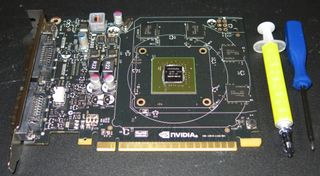Build Your Own: Single-Slot GeForce GTX 750 Ti
We already proved that it's possible to game on a GeForce GTX 750 Ti with a passive heat sink. Now we're going to do the same thing with a single-slot cooler. Can you build your own low-profile board based on GM107? Sure, if you have the right AMD donor.
Building Our Own Nvidia/AMD Hybrid
Victor Frankenstein, I am not. But you might say that it's a little disrespectful to put an AMD heat sink and fan on a half-naked Nvidia card. In this case, though, it's better to get some answers than it is to match the right colors together. And because Nvidia's partners didn't launch with a single slot model of their own, we felt it was necessary to take that extra step and show it could be done. One of the readers on the Tom's Hardware U.S. forum called our last dalliance “Frankenmod”, and that's not far from the truth.
The first step is to remove the small heat sink with its axial fan from AMD's FirePro V3900 and clean it. Why are we using this cooler, specifically? None of the other single-slot solutions we looked at would fit because Nvidia's reference PCB employs some fairly tall capacitors. This was the only heat sink and fan combo in arm's reach that'd honor the height of one expansion slot.

Although this was the only cooler that fit, it still presented us with a unique issue. As you can see in the picture, its power lead is short. It also happens to be on the wrong side to work easily with a GeForce GTX 750 Ti. So, we had to fashion an adapter that'd make it possible for the card to control fan speeds.

In Passively Cooling Nvidia's GeForce GTX 750 Ti...With An AMD Sink, we explained in detail how we were able to make heat sinks from AMD cards fit on Nvidia graphics cards, despite different screw hole spacing. If you haven't already, check out that piece for the step-by-step of how we enlarged the holes on our GeForce board. For those who already read it, the pictures below are there to refresh your memory.




As they say, no pain, no gain. Without enlarging the screw holes, you won't be able to transplant the heat sink from AMD's FirePro V3900. To be honest, though, even an experimental kid could do this without messing anything up. Just be careful not to hurt yourself!
Stay on the Cutting Edge
Join the experts who read Tom's Hardware for the inside track on enthusiast PC tech news — and have for over 25 years. We'll send breaking news and in-depth reviews of CPUs, GPUs, AI, maker hardware and more straight to your inbox.
Current page: Building Our Own Nvidia/AMD Hybrid
Prev Page Nvidia Gets A Little More Support From An AMD Cooler Next Page Meet The Finished Product-
de5_Roy i've been waiting to read it for a while. it was very good.Reply
one aspect of gcn based radeons is that despite their low power use in entry level cards, all of them use higher amount of pwoer during bluray playback. both kepler and maxwell (gm107) use quite less. a single slot, low profile operation, a card with gpu like gm107 will be very suitable for htpc. not to mention the sheer amount of gaming performance advantage over other gfx card around the same power use. hopefully, the future 20nm gpus will introduce even more performance under the same power use. -
dish_moose I get a little cautious about making holes in multi layer pcbs and using metal screws. Without knowing the power plane structure and clearances, you gamble shorting out internal layers if you are not lucky/careful.-BruceReply -
jamesedgeuk2000 I think I have noticed a flaw with what you guys did here. The card only supply's power to the fan it doesn't regulate PWM or sense RPM, so am I correct in assuming that it's using voltage regulation to control fan speed and therefore doing it blind based on it's temperature curve? If so then as you have replaced the standard fan with a much weaker one you should really consider raising the fan curve to compensate.Reply -
CodeMatias Why not use a K2000 cooler? also nvidia small die so it might work better, and K2000 is ~80W so it should cool the 750ti just fine.Reply -
CodeMatias ReplyAnd now... fitting a Titan/780 Ti cooler to a 290X. ;)
Asus already did... It doesn't work, the 290X just draws too much power -
AndrewJacksonZA Reply
Yes silverblue, yes! :-)12865804 said:And now... fitting a Titan/780 Ti cooler to a 290X. ;)